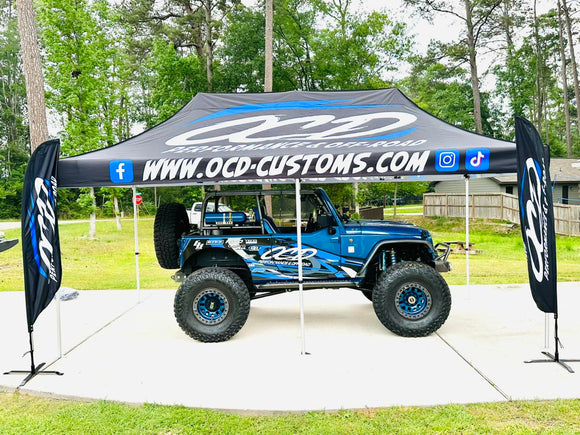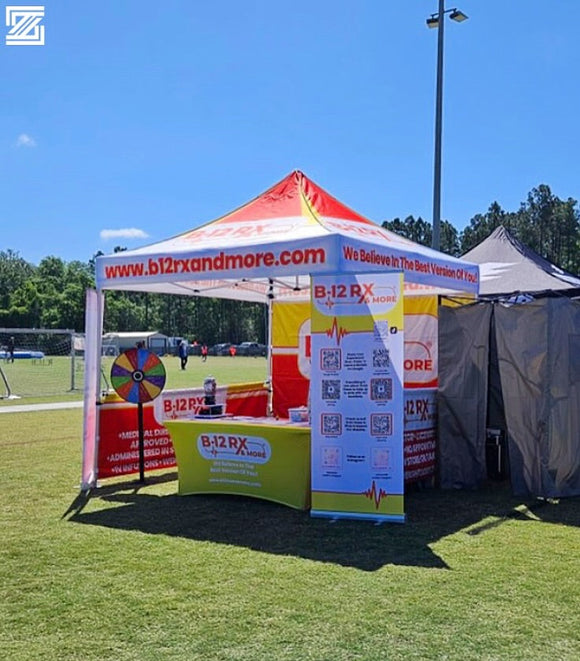
The Complete Guide to Trade Show Booth Design: 7 Tips That Actually Work
Trade shows represent a $14.3 billion industry, yet 87% of exhibitors struggle to generate meaningful leads from their investment. After helping over 10,000 customers create successful trade show experiences, we've identified the key factors that separate winning booths from forgettable ones.
Whether you're a first-time exhibitor or looking to improve your current setup, this guide will walk you through seven proven strategies that actually move the needle on your trade show ROI.
-
Choose Your Booth Size Strategically
The biggest mistake we see? Companies thinking they know what they need, rather than having a clear understanding of what makes sense for their goals.
The Real Difference Between Tent Sizes:
10' x 10' Pop-Up Tents (100 sq ft)
- Perfect for: New exhibitors, local shows, product demonstrations
- Visitor capacity: 6-8 people comfortably
- Best for: Single product focus or service-based businesses
10' x 15' Pop-Up Tents (150 sq ft)
- Perfect for: Growing businesses, multiple product lines
- Visitor capacity: 10-12 people comfortably
- Best for: Companies wanting meeting space + display area
10' x 20' Pop-Up Tents (200 sq ft)
- Perfect for: Established brands, major industry shows
- Visitor capacity: 15-20 people comfortably
- Best for: Full product showcases with dedicated meeting areas
Pro Tip: Consider the show's expected attendance and your lead generation goals. A cramped 10x10 at a major show might hurt more than help, while a sparse 10x20 at a local event could seem wasteful.
2. Create Visual Hierarchy That Guides the Eye
Your booth needs to tell a story in 3 seconds or less. Here's how successful exhibitors structure their visual hierarchy:
The 3-Second Rule Structure:
1. Eye-catching header (your main message/value proposition)
2. Supporting visuals (product images, benefits)
3. Call-to-action (what you want visitors to do)
Banner and Backdrop Strategy:
- Roll-up banners: Position at booth corners to frame your space
- Photo backdrops: Create Instagram-worthy moments that extend your reach
- Pole flags: Use outside your booth to draw attention from aisles
The key is consistency. Your banners, table covers, and promotional materials should work together as a cohesive visual system, not compete for attention.
3. Master the Art of Table Presentation
Your table isn't just furniture—it's prime real estate for conversion.
Table Cover Types and When to Use Them:
Stretch-Fit Table Covers
- Modern, wrinkle-free appearance
- Best for: Tech companies, professional services
- Advantage: Easy setup, always looks crisp
Standard Draping Table Covers
- Classic, professional look
- Best for: Traditional industries, formal presentations
- Advantage: Hides storage underneath effectively
Fitted Table Covers
- Tailored appearance, custom branding opportunities
- Best for: Premium brands, detailed product displays
- Advantage: Maximum branding real estate
What Goes ON Your Table Matters:
- Lead capture forms (make them simple!)
- Product samples or demos
- Business cards in attractive holders
- One compelling promotional item (not five different ones)
4. Select Promotional Products That Actually Work
After analyzing thousands of successful trade show campaigns, certain promotional products consistently outperform others in generating follow-up conversations.
High-Performance Promotional Items:
Cell Phone Stands
- Why they work: Daily use = daily brand exposure
- Best for: Tech, finance, consulting industries
- ROI factor: High utility, low cost
Custom Business Cards
- Why they work: Professional credibility, easy to share
- Best for: All industries (universal need)
- ROI factor: Essential for lead capture
Can Coolers
- Why they work: Social sharing, extended use
- Best for: Outdoor, lifestyle, food & beverage brands
- ROI factor: High visibility at events and beyond
Items That Usually Don't Work:
- Cheap pens (everyone has them)
- Stress balls (novelty wears off quickly)
- Generic tote bags (unless they're exceptional quality)
5. Design for Engagement, Not Just Display
The most successful booths create reasons for meaningful conversations, not just product showcases.
Engagement Strategies That Work:
- Interactive demonstrations (let visitors try your product)
- Quick consultations (offer immediate value)
- Photo opportunities (branded backdrops for social sharing)
- Educational content (solve problems, don't just sell)
The Conversation Starter Formula:
Instead of "What does your company do?" train your team to ask:
"What's your biggest challenge with [relevant industry problem]?"
This immediately positions you as a problem-solver, not a vendor.
6. Plan Your Setup for Efficiency and Impact
Your booth design should make setup easy and breakdown faster. After working with 10,000+ customers, we've learned that complicated setups lead to stressed teams and poor performance.
The 4-Step ZuLu Process Applied to Booth Design:
ORDER Phase: Choose components that work together seamlessly
DESIGN Phase: Create cohesive branding across all elements
APPROVE Phase: Test your setup before the show
SHIP Phase: Ensure everything arrives with time to spare
Setup Day Success Tips:
- Arrive early (seriously, this can't be overstated)
- Bring a setup checklist
- Test all technology before attendees arrive
- Have backup plans for common issues
7. Measure What Matters (Beyond Just Lead Count)
Most exhibitors focus solely on lead quantity, but successful companies track metrics that predict actual sales.
Key Performance Indicators to Track:
- Quality conversations (meaningful discussions vs. quick chats)
- Follow-up response rates (how many leads actually engage post-show)
- Cost per qualified lead (total investment ÷ sales-ready prospects)
- Social media engagement (booth photos, mentions, shares)
Post-Show Success Metrics:
- Leads converted to sales meetings within 30 days
- Actual revenue generated from show contacts
- Brand awareness lift in target market
- Customer acquisition cost compared to other channels
Putting It All Together: Your Next Steps
Creating a successful trade show booth isn't about having the biggest budget—it's about making strategic decisions that align with your goals and audience.
Ready to Get Started?
1. Assess your current setup against these seven principles
2. Identify your biggest opportunity for improvement
3. Plan your next show with these strategies in mind
Need Expert Guidance?
Our team has helped over 10,000 customers create trade show experiences that drive real results. We offer free 20-minute video consultations where we'll review your specific situation and provide customized recommendations.
Ready to create your winning trade show booth? Visit zulumap.com or call (833) 985-8627 to get started.
---
About ZuLu Marketing & Printing: We're a custom promotional and branded merchandise company that's helped over 10,000 customers succeed at trade shows and events. For every order placed, we donate 10 meals to a child in Nairobi, Kenya, providing a full week of nourishment. Follow us @zulumap on Facebook and Instagram.


